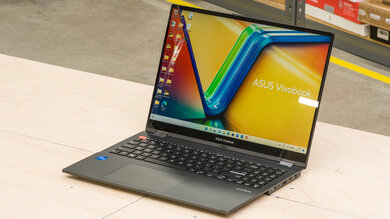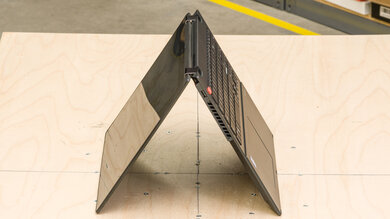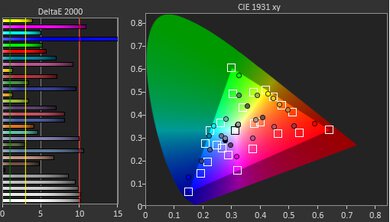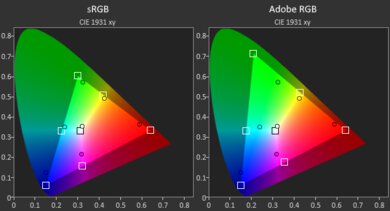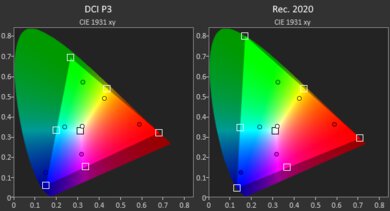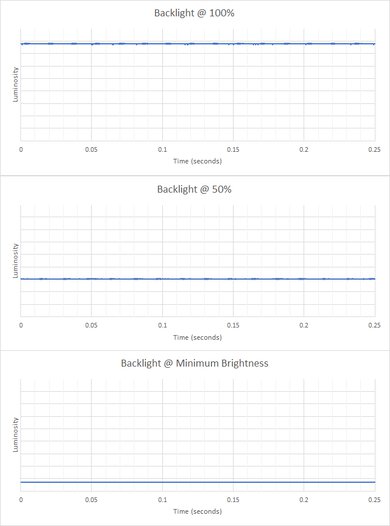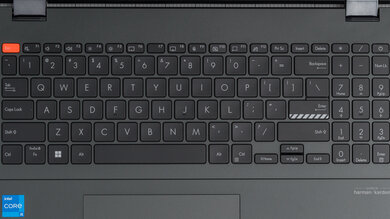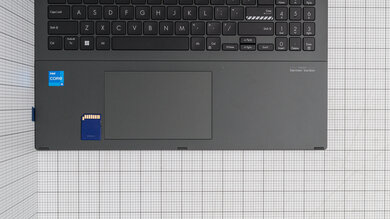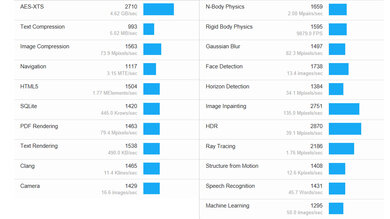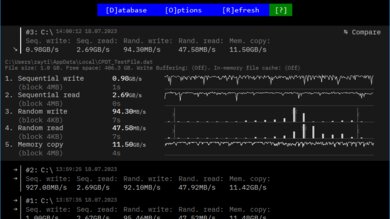The ASUS Vivobook S 16 Flip TP3604 (2023) is a mid-range 2-in-1 convertible laptop. It's available with Intel 13th Gen U-series and H-series CPUs, integrated graphics, and up to 16GB of RAM and 1TB of storage. You can configure it with an FHD+ (1920 x 1200) IPS or a 3.2k (3200 x 2000) OLED display. The displays have stylus support, though the pen is a separate purchase. It has Wi-Fi 6E wireless connectivity, a 1080p webcam, and a fingerprint sensor. Ports include two USB-As, one USB-C, an HDMI, and a 3.5mm headphone jack. The USB-C port supports charging and video output but not Thunderbolt 4 or USB4.
You can see our unit's specifications and the available configuration options in the Differences Between Variants section.
Our Verdict
The ASUS Vivobook S 16 Flip is decent for school use. It feels well-built and is fairly easy to carry around. It has a 16-inch display that's well suited for split-screen multitasking, a spacious and comfortable keyboard, and a large, responsive touchpad. It's available with Intel 13th Gen U-series or H-series CPUs; the former can handle general productivity tasks, while the latter is better suited for demanding workloads like programming. There aren't any discrete GPU options, so it isn't ideal for students needing lots of GPU processing power, like 3D graphics and animation. Unfortunately, the battery lasts only around six hours of light use, and the USB-C port doesn't support Thunderbolt 4.
- Fairly easy to carry around.
- Comfortable keyboard, responsive touchpad.
- Available with sharper, brighter OLED display.
- Great 1080p webcam.
- Short battery life.
- Dim IPS display.
- Integrated graphics can't handle demanding workloads.
- No Thunderbolt 4 support.
The ASUS Vivobook S 16 Flip is mediocre for gaming. Although you can get this laptop with a powerful H-series CPU, it's only available with integrated graphics, which aren't powerful enough to handle demanding AAA titles. Older titles and light puzzle-like games will run, but you'll have to play at a lower resolution or with low graphical settings to get smooth gameplay. As for the display, you can get the laptop with a 120Hz OLED panel, which will provide a better gaming experience than the 60Hz IPS panel, but again, the integrated graphics can't push high frame rates, and neither display supports VRR to reduce screen tearing. Also, the fan is loud under load.
- Comfortable keyboard, responsive touchpad.
- Fast, user-replaceable SSD.
- Integrated graphics can't handle demanding workloads.
- Can only get up to 16GB of RAM.
- No VRR to reduce screen tearing.
The ASUS Vivobook S 16 Flip is decent for media consumption. It's fairly easy to carry around for a 16-inch device, as it isn't overly bulky or heavy. The FHD+ IPS display looks slightly washed out and doesn't get bright enough to combat glare; however, you can get the laptop with a 3.2k OLED display, which will provide a significantly better viewing experience, especially in dark settings. The OLED display has full DCI P3 coverage, making it great for viewing HDR content. As for the speakers, while they get very loud and sound full, they lack bass like most laptop speakers. Its battery life is okay; you can get about five to six hours of video playback on a full charge.
- Fairly easy to carry around.
- Comfortable keyboard, responsive touchpad.
- Available with sharper, brighter OLED display.
- Loud, full-sounding speakers.
- Short battery life.
- Dim IPS display.
- Speakers lack bass.
The ASUS Vivobook S 16 Flip is good for use as a workstation. It's available with Intel 13th Gen H-series CPUs, which are powerful enough to handle demanding tasks; however, don't expect to do anything GPU-intensive, as the integrated graphics perform poorly, and there aren't any discrete GPU options. Also, you can only get up to 16GB of RAM. You can do some color work, though, as the 3.2k OLED display has full DCI P3 coverage. The keyboard doesn't get hot under load, but the fan is loud. Unfortunately, the USB-C port doesn't support Thunderbolt 4 or USB4.
- Comfortable keyboard, responsive touchpad.
- Available with powerful H-series CPUs.
- OLED display has full DCI P3 coverage.
- Fast, user-replaceable SSD.
- Integrated graphics can't handle demanding workloads.
- No Thunderbolt 4 support.
- Can only get up to 16GB of RAM.
The ASUS Vivobook S 16 Flip is decent for business use. It feels very well-built and is relatively easy to carry around for a 16-inch laptop. It has a large display for multitasking, a comfortable keyboard, and a large, responsive touchpad. Its Intel 13th Gen CPU can easily handle general productivity tasks like text processing, spreadsheets, presentations, and video playback. You get a great 1080p webcam for video calls, a fingerprint sensor for quick logins, and a decent number of ports. The downsides are that the battery lasts only around six hours of light use, and the USB-C port doesn't support Thunderbolt 4 or USB4.
- Fairly easy to carry around.
- Comfortable keyboard, responsive touchpad.
- Available with sharper, brighter OLED display.
- Great 1080p webcam.
- Short battery life.
- Dim IPS display.
- No Thunderbolt 4 support.
Changelog
- Updated Dec 07, 2023: Converted to Test Bench 0.8.2.
- Updated Nov 03, 2023: Converted to Test Bench 0.8.1.
- Updated Oct 19, 2023: Added mention of the MSI Modern 14 (2023) as a more portable alternative in the Portability section.
- Updated Aug 04, 2023: Added mention of the HP Pavilion Plus 14 (2023) as an alternative with a discrete GPU in the GPU section.
Differences Between Sizes And Variants
We tested the ASUS Vivobook S 16 Flip with an Intel Core i5-1335U CPU, Intel Iris Xe integrated graphics, 16GB of RAM, and 512GB of storage. The CPU, memory, and storage are configurable; the available options are in the table below.
| Screen |
|
|---|---|
| CPU |
|
| GPU |
|
| Memory |
|
| Storage |
|
| Color |
|
You can see our unit's label here.
Popular Laptop Comparisons
The ASUS Vivobook S 16 Flip is a decent laptop overall. It feels very well built compared to other laptops in its class and provides a good user experience; however, its battery life is sub-par, and its lack of keyboard backlighting is disappointing.
For more options, see our recommendations for the best Windows laptops, the best 2-in-1 laptops, and the best budget and cheap laptops.
The ASUS Zenbook 14 OLED (2024) is much better than the ASUS Vivobook S 16 Flip TP3604 (2023). Although both are ultraportables designed for general productivity, the Zenbook is a more premium model with better build quality, more performance, and longer battery life, while the Vivobook is more budget-friendly. The Vivobook is a good option for its price; its main flaw is its short battery life.
The ASUS Zenbook 14 Flip OLED (2023) is much better than the ASUS Vivobook S 16 Flip TP3604 (2023). The Zenbook has a sturdier all-metal build, a better keyboard and touchpad, and longer battery life. It also has Thunderbolt 4 support, which the Vivobook lacks. It's more portable than the Vivobook since it's a smaller device, but you don't get as much screen real estate for multitasking. The Vivobook is available with more powerful H-series CPUs and doesn't throttle as much as the Zenbook under load.
The ASUS Vivobook S 16 Flip TP3604 (2023) and the ASUS Vivobook 16 M1605 (2023) are both 16-inch ultraportables. The TP3604 is more versatile since it's a 2-in-1 convertible with stylus support, and it's available with more powerful H-series CPUs and a nicer 3.2k OLED display. It also has a higher resolution 1080p webcam and better-sounding speakers. On the other hand, the M1605 has longer battery life and doesn't throttle as much under load.
The Lenovo IdeaPad Flex 5i 14 (2022) is slightly better than the ASUS Vivobook S 16 Flip TP3604 (2023). The Lenovo has a better keyboard with backlighting, longer battery life, and a wider port selection with Thunderbolt 4 support. However, the ASUS has a larger display for multitasking, and it's available with more powerful CPUs and a nicer OLED display.
Test Results

The ASUS Vivobook S 16 Flip has a fairly sleek, professional design with a slim chassis, thin bezels, glossy chrome hinges, and a full-size keyboard with a Numpad on the right. On the bottom, you'll find the speakers near the front and air vents near the back. There are also air vents on the back of the laptop. It's available in two colors: Cool Silver and Midnight Black.
The build quality is great. The construction is a mix of aluminum and plastic. Though not particularly premium, it feels very sturdy, exhibiting only a little flex on the lid, keyboard deck, and display. The finish feels smooth and doesn't scratch easily, but the Midnight Black model picks up a lot of fingerprints. The whole device feels hefty, with evenly-distributed weight.
The hinges are passable. They feel smooth when opening and closing the lid, but they're stiff, making it impossible to open the laptop with one hand. There's a fair amount of wobbling when touching the screen or typing aggressively, which can be annoying.
The ASUS Vivobook S 16 Flip isn't overly bulky or heavy, but it's still a 16-inch device, so it might not fit into smaller bags. Thankfully, the power adapter is compact and lightweight. If you want a more compact laptop for on-the-go use, check out the MSI Modern 14 (2023).
The ASUS Vivobook S 16 Flip's serviceability is okay. Opening the laptop is easy; you only need to remove nine Philips screws and undo the bottom panel clips. Unfortunately, there's only one SO-DIMM memory slot since the other 8GB of memory is soldered onto the motherboard, and the SO-DIMM slot is extremely difficult to access without causing damage to the motherboard. As such, we consider the RAM to be non-replaceable.
The ASUS Vivobook S 16 Flip is available with the following displays:
- 16" IPS 1920 x 1200 60Hz Touchscreen
- 16" OLED 3200 x 2000 120Hz Touchscreen
The 1080p display looks decently sharp on a 16-inch screen. If you're close, you can see individual pixels, but it isn't a problem at normal viewing distances. The 3.2k OLED panel has a pixel density of 236 PPI and looks much sharper; however, its increased resolution and OLED's higher power consumption will drain the battery faster. Also, remember that OLEDs are susceptible to permanent burn-in, especially with static desktop elements like Windows' taskbar. The display's 16:10 aspect ratio is great for productivity, as it lets you see more information at once when reading a document or website, reducing the need to scroll. The downside is that you'll have black bars at the top and bottom when viewing standard 16:9 videos.
Note: ASUS sometimes advertises models with an IPS panel as the ASUS Vivobook S 16 Flip OLED, so check the specifications to ensure you're getting the correct configuration.
The IPS panel has a basic 60Hz refresh rate, and its slow response time causes noticeable ghosting. The 3.2k OLED panel has a 120Hz refresh rate and likely a much faster response time (OLEDs usually have a near-instantaneous response time), resulting in smoother motion and less blur trail behind moving objects. Its higher refresh rate also makes the system feel more responsive, especially when using a stylus, scrolling through a document, or gaming. Neither display supports variable refresh rate to reduce screen tearing.
The display's contrast ratio is great for an IPS panel; however, this contrast level is still relatively low compared to other display technologies, making blacks look gray in dim settings. The 3.2k OLED panel is a significantly better option for dark room viewing. Its contrast ratio is effectively infinite since OLEDs can turn off individual pixels to produce perfect, inky blacks.
The IPS panel doesn't get very bright. It's fine for most indoor settings but not for sunny or well-lit rooms or outdoors in broad daylight. The OLED panel has an advertised brightness of 400 cd/m² in SDR and 500 cd/m² in HDR, though it likely only gets to 500 cd/m² in dark scenes with small highlights. The display gets very dim at the lowest brightness setting, which helps reduce eye strain when viewing content in the dark.
The display's reflection handling is mediocre. Its glossy finish struggles with mirror-like reflections and doesn't do much to reduce the intensity of bright light sources, like a lamp or open window during the day. These reflections are visible even with the screen at maximum brightness. If you're concerned about reflections, getting a model with an OLED display is best, as it can get brighter to compensate.
The display's horizontal viewing angle is okay. The image dims and washes out relatively quickly as you move to the side. You must be almost directly in front of the screen to see an accurate image.
The vertical viewing angle is acceptable. Again, the image looks dimmer and more washed out from above or below. You need to look at the screen more or less straight on if you need perfect accuracy, which can be hard in tight spaces with very little room to tilt the screen, like on a bus or airplane.
The IPS display's out-of-the-box accuracy is bad. The white balance is very inaccurate, as there's a greenish hue at higher brightness levels, and most colors are off because the IPS panel has a narrow color gamut. The color temperature is a little warmer than the standard 6500K target, resulting in a slight reddish tint. The gamma doesn't follow the sRGB curve; most scenes are too bright, while dark scenes are too dark. It's worth noting that the display doesn't look bad; it's fine for general productivity, but don't expect to do any color-critical work. The OLED panel has a much wider color gamut, so even if its factory calibration isn't good, you can still correct it to a certain extent with an ICC profile.
The IPS panel has a poor color gamut. It doesn't even have full coverage of the commonly-used sRGB color space, making most content look slightly washed out, with colors like pure green and red looking darker and less saturated. The IPS panel isn't ideal for color-critical work like photo and video editing. The manufacturer advertises the OLED display as having 100% DCI P3 coverage, making it suitable for viewing and producing HDR content.
The display's backlight is entirely flicker-free, which helps reduce eye strain. The OLED panel flickers because there's a drop in brightness at every frame change; however, the brightness dip is extremely small and isn't noticeable to most people.
The ASUS Vivobook S 16 Flip's keyboard feels good to type on. The layout is spacious and fairly standard, so it's easy to get used to. The keys have a good amount of travel, don't require much force to actuate, and provide relatively satisfying tactile feedback. They aren't outright mushy, but they're on the softer side, especially when bottoming out. The keycaps are okay in quality; they don't feel premium or overly cheap. Likewise, key stability is decent but could be better. Typing noise is low and isn't bothersome in quiet settings. Unfortunately, there's no backlighting.
The ASUS Vivobook S 16 Flip has a great touchpad. It's large and smooth and tracks all movements and gestures well. There's no problem with palm rejection, though dragging and dropping doesn't always work. The clicking mechanism feels relatively satisfying, but you can only click in the bottom half of the touchpad.
The ASUS Vivobook S 16 Flip's speakers get very loud with minimal compression artifacts at max volume. They sound clear, natural, and full. However, they have very little bass, so they aren't ideal for bass-heavy music.
The webcam's video quality is great. The image has a fair amount of fine details and true-to-life colors, but it looks a tad washed out, with some noise in a few areas. As for the microphone, although voices sound clear, there's audible static background noise. The microphone also accentuates sibilants, which can annoy people sensitive to high frequencies.
The ASUS Vivobook S 16 Flip has a decent port selection. The USB-A port on the left supports USB 2.0 data transfer speed of up to 480Mbps, while the one on the right supports USB 3.2 Gen 2 (up to 10Gbps). The USB-C also supports USB 3.2 Gen 2 data transfer speed, as well as DisplayPort and Power Delivery. The latter allows for fast charging of the laptop and other PD-compatible devices connected to the port. Although ASUS advertises the HDMI port as HDMI 2.1, we list it as HDMI 2.0 because it uses the TMDS (Transition Minimised Differential Signaling) signaling method, which only supports up to a maximum output of 4k at 60Hz (8-bit).
The wireless adapter is an Intel Wi-Fi 6E AX211.
The ASUS Vivobook S 16 Flip is available with the following CPUs:
- Intel Core i3-1315U (6 cores/8 threads, up to 4.50GHz, 10MB cache)
- Intel Core i5-1335U (10 cores/12 threads, up to 4.60GHz, 12MB cache)
- Intel Core i5-13500H (12 cores/16 threads, up to 4.70GHz, 18MB cache)
- Intel Core i7-13700H (14 cores/20 threads, up to 5.00GHz, 24MB cache)
- Intel Core i9-13900H (14 cores/20 threads, up to 5.40GHz, 24MB cache)
The U-series CPUs are low-power processors typically found in thin, light laptops. They're designed for general productivity tasks like text processing, web browsing, spreadsheets, and video playback. They can also handle moderately demanding tasks like photo editing. If you have a very intensive workload, it's best to go with one of the H-series CPUs, which are processors typically found in mobile workstations and gaming laptops. They perform better than the U-series CPUs, having more cores and running at higher clock speeds. However, they also consume more power and drain the battery faster.
The ASUS Vivobook S 16 Flip is only available with integrated graphics. The Core i3 has Intel UHD graphics, while the Core i5, i7, and i9 have Intel Iris Xe. These integrated GPUs are designed to handle light tasks like web browsing and video playback, not demanding workloads like video editing or 3D graphics. You can play puzzle-like and strategy games on models with Iris Xe, but you'll likely have to play at a lower resolution or with low graphical settings to get smooth gameplay. The Core i7-13700H and i9-13900H's Iris Xe perform better than the Core i5-1335U and i5-13500H's because they have more execution units; however, the performance difference is small. If you need a thin, light laptop with a discrete GPU, check out the HP Pavilion Plus 14 (2023).
You can configure this laptop with 8GB or 16GB of RAM. Both configurations have 8GB of soldered memory and a SO-DIMM slot (occupied on the 16GB model), so you can upgrade the 8GB model up to 16GB yourself. While most people with a light workload can get by with 8GB of memory, it's worth upgrading to 16GB. Not only will it give you more headroom for heavy multitasking, but it'll also allow the system to run in dual-channel mode, improving performance. That said, as mentioned in the serviceability section, the SO-DIMM slot is very hard to access without causing damage, so it's best to get the 16GB upfront.
You can configure this laptop with 256GB, 512GB, or 1TB of storage. ASUS advertises that the 512GB and 1TB are PCIe Gen 3 SSDs; however, the 512GB SSD in our unit is a PCIe Gen 4 drive. The SSD is user-replaceable; the slot supports M.2 2280 PCIe Gen 4 SSDs.
The ASUS Vivobook S 16 Flip with an Intel Core i5-1335U has an excellent overall score in the Geekbench 5 benchmarks. All of the available CPUs can easily handle general productivity tasks. The U-series processors can handle moderately intensive tasks, but it's best to go with one of the H-series CPUs for truly demanding, multi-threaded workloads like video editing. As for GPU computing tasks, the CPU's integrated graphics perform poorly. If your workload requires a lot of GPU processing power, a laptop with a discrete GPU or an Apple MacBook Pro with an Apple ARM-based SoC is best.
The overall score in Cinebench R23 is outstanding. The Intel U-series CPUs can handle 3D rendering and other similarly demanding workloads. If you want faster rendering times or a smoother experience, get the H-series processors because they have more cores to provide better multi-thread performance.
The Intel Core i5-1335U CPU performs well in Blender but is still far slower than GPU rendering. If you must render with the CPU in Blender, an H-series processor with more cores and threads is best, like the i7-13700H or i9-13900H. Otherwise, get a laptop with a discrete GPU. Even an entry-level GPU like an NVIDIA GeForce GTX 1650 can render images faster than any CPU available on this laptop.
The ASUS Vivobook S 16 Flip performs poorly in the Basemark GPU benchmark. Intel's UHD Graphics and Iris Xe aren't designed for gaming. The more powerful Iris Xe can handle simple, puzzle-like games or older titles, but you'll have to play at a lower resolution or with low graphics settings to get playable frame rates.
The storage drive performance is outstanding. It isn't a particularly fast PCIe Gen 4 SSD, but it's plenty fast for a budget-friendly general productivity laptop. The system boots up, launches apps, and transfers files quickly. The 1TB SSD is likely faster, as larger SSDs tend to perform better.
The ASUS Vivobook S 16 Flip's battery life is sub-par. Regardless of what you do, you must plug it in to get through a typical work or school day. Models with an H-series CPU have a 50Wh battery, but since the H-series processors consume more power, the larger capacity likely will result in shorter battery life. ASUS says you can get models with a 70Wh battery, though we have yet to see one available. Models with a 3.2k OLED display will have shorter battery life.
Borderlands 3 and other similarly demanding games aren't playable on the ASUS Vivobook S 16 Flip because the Intel CPU's integrated graphics can't handle such graphically intensive titles. The average frame rate is too low, even with the lowest settings, and there are frequent stutters due to frame drops.
Civilization VI and similar strategy games are playable on models with Intel Iris Xe graphics, but you must play with low settings. The turn time is decent and within the expected range for an Intel 13th Gen U-series CPU. Upgrading to an H-series CPU will improve the turn time slightly.
The performance in CS:GO is sub-par. The gameplay is very choppy, even with low graphical settings. Upgrading to the Core i7-13700H and i9-13900H will get you slightly higher frame rates, but you'll still experience occasional stutters, which isn't ideal for an FPS game.
Shadow of the Tomb Raider and other similar AAA titles aren't playable on the ASUS Vivobook S 16 Flip at 1080p. The average frame rate is too low, even with low graphical settings. You can get over 30 fps at 720p, but the game still stutters due to frame drops.
The keyboard is cool when idle and only gets mildly warm under load. The fan, however, is pretty loud. It gets even more audible in the Performance mode, up to 52dBA.
The ASUS Vivobook S 16 Flip's performance over time is great. Neither the CPU nor the GPU gets hot under load. The CPU throttles quickly within minutes of starting an intensive workload, and it takes about half an hour before the performance stabilizes. The throttling on the GPU isn't noticeable. Models with an H-series CPU will likely throttle more because those processors run at a higher wattage.
The ASUS Vivobook S 16 Flip has many pre-installed applications, including:
- Alexa: Amazon's digital assistant.
- Clipchamp: Video editing software
- Dolby Access: Adds Dolby Atmos support and lets you set up Dolby Atmos devices.
- GlideX: Lets you mirror your screen's content to a smartphone, tablet, or computer.
- McAfee Live Safe: Antivirus and internet security software. Requires subscription.
- McAfee WebAdvisor: Protection against malware when browsing the internet.
- MyAsus: Lets you access power, fan, and display color profiles.
- ScreenXpert: Window management utility for multi-display setups.
The ASUS Vivobook S 16 Flip has a fingerprint sensor built into the power button. You can use it to log into Windows, authorize Windows Store purchases, and auto-fill saved passwords on supported websites. The display supports pen input, but you must buy the stylus separately. ASUS recommends using the ASUS Pen 2.0, although any MPP (Microsoft Pen Protocol) 2.0 pen will work.

